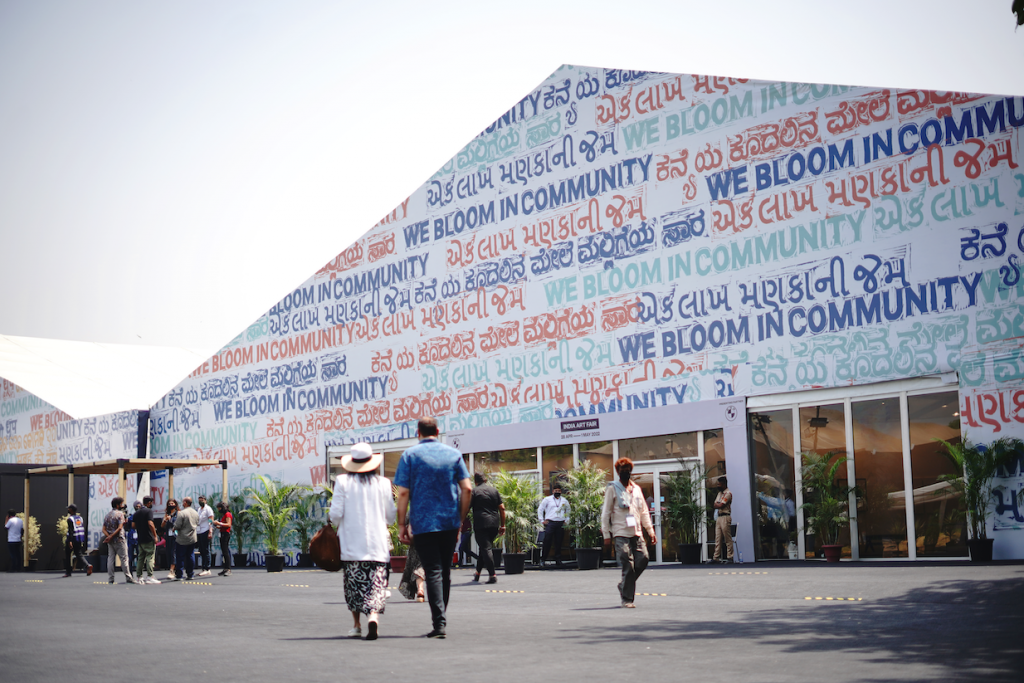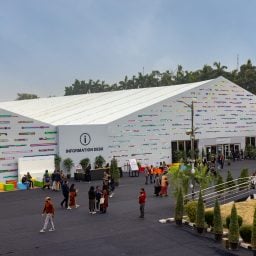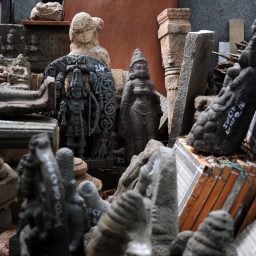“Watch out, it can be addictive,” states the opening paragraph of How to buy your first piece at India Art Fair, an online guide for new collectors. And on the fair’s opening day last week, eager art buyers showed just how much of a compulsion collecting can be, arriving in force despite record temperatures in New Delhi and a new wave of the pandemic looming. During the VIP preview on Thursday, rows of orderly, plush cars patiently waited to reach the fair entrance and the white tents were packed with crowds.
The fair’s late-night parties, too, were booming. The preview days drew to a close with a bash at the atelier of designer Raw Mango, the garden strewn with hundreds of rose and jasmine petals. The dance floor thrummed, and the saris glinted under a new moon solar eclipse.
In fact, this year’s edition of the fair—the first to take place since the pandemic started—appeared to be one of the most well-attended. The organizers credit the turn-out to the effort it made to explain the purchasing process to potential first-time buyers and bring in a fresh crop of collectors, such as interior designers, architects, lawyers, and tech entrepreneurs.
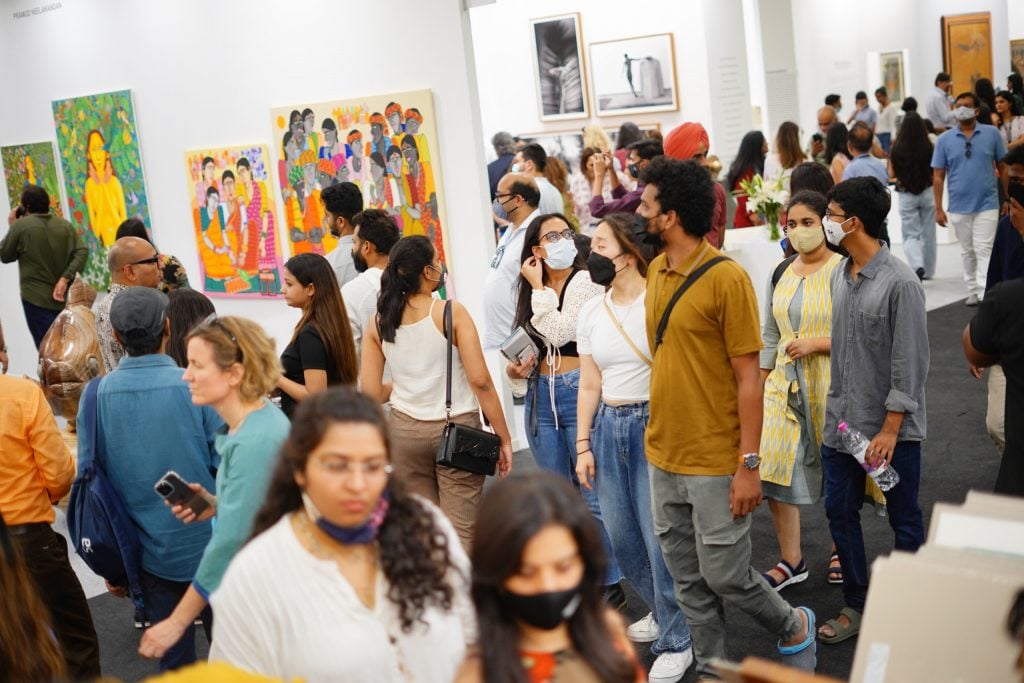
Visitors at India Art Fair 2022. Photo: © India Art Fair.
India’s most influential and prolific art collector Kiran Nadar told Artnet News that she was pleasantly surprised at how often she inquired about works that had already been sold, just a few hours into the first day. “And to young collectors,” Nadar added. The founder of the Kiran Nadar Museum of Art, she is one of the country’s most involved art patrons. “But it’s time for there to be many more like me,” she said, smiling.
The more well-established galleries also noted good sales, each one emphasizing their delight at visitors’ response to the fair after its hiatus. “We are thrilled to be back,” said Priya Jhaveri of Jhaveri Contemporary, which is based in both Mumbai and London. “The energy and enthusiasm has been unmatched. We have nine artists in the booth and have sold works by each of them, priced between $3,600 and $45,000.” Hena Kapadia, of TARQ, Mumbai, noted an interest in large-scale works by artists that have seen success in recent years, with works priced from $1,000 to $13,000.
Gallery SKE from New Delhi had a characteristically intimate and well-considered presentation of works, including a stunning, life-size painting by hyper-real artist Abir Karmakar, known for his scenes of domestic interiors. This new work shows a set of terraces set against a background of ominous, thickening dark clouds, which seemed to reflect the apocalyptic skies that hung above visitors throughout the duration of the fair.
Another highlight of Gallery SKE’s booth were delicate pencil drawings by Faiza Hasan depicting tender family moments that covered an entire wall. These were joined by ceramic glazed garlands by Rajyashri Goody, each named after one virtue of Buddhist teachings.
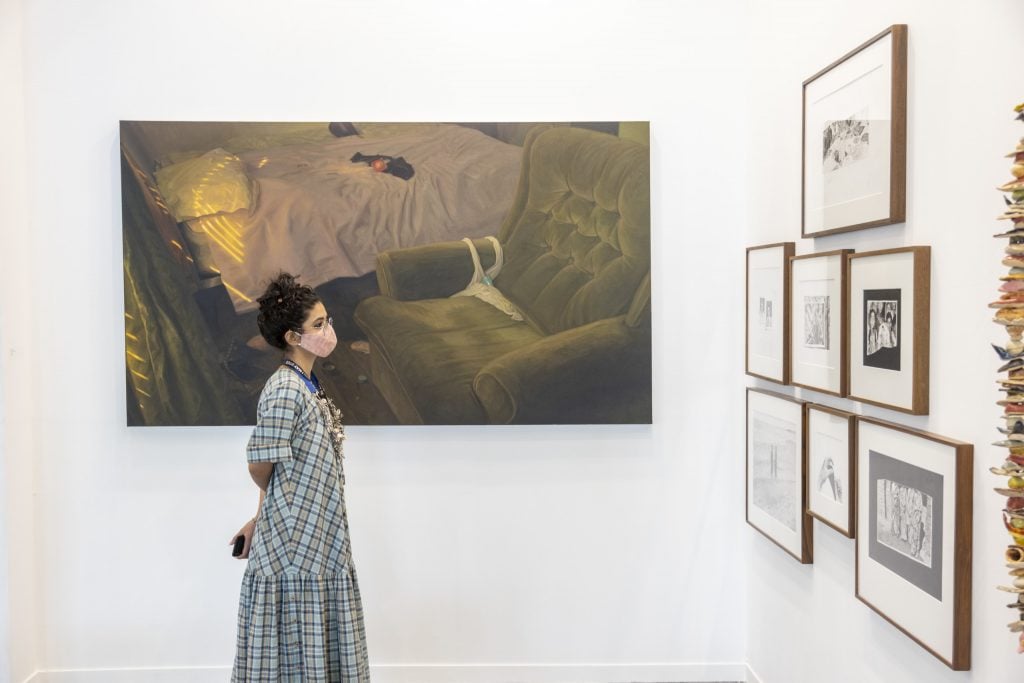
Gallery SKE’s booth included works by hyper-real artist Abir Karmakar (background) and delicate pencil drawings by Faiza Hasan (right). Photo: © India Art Fair.
Experimenter Gallery, Kolkata, showed works by the Turner Prize-nominated artist Naeem Mohaiemien alongside Bani Abidi, as well as Aziz Hazara, who is included in this year’s Venice Biennale group exhibition. The gallery also dedicated a whole wall to watercolors of submerged Goan landscapes, by the young artist Sahil Naik.
Despite the crowds, the presence of international collectors at the fair was slim this year, when compared to previous editions, which have seen museum acquisition teams arriving from institutions such as the Tate in London and the Centre Pompidou in Paris. In the face of travel restrictions and hesitations, the fair organizers focused on the local scene, and there was thus a mix in pricing on the work on offer, with some objects starting as low as $200. Foundations and artist-run spaces also had affordable works by prominent and younger artists in the fair’s “Institutions” section.
The Chennai Photo Biennale Foundation, for instance, was selling prints, folios and student works as a way to raise funds for its yearly workshops, labs and public art initiatives. This included a set of prints by artist Gauri Gill, from her photographic series Balika Mela, a project focusing on rural Rajasthan which she has worked on for over a decade. The HH Art Spaces booth was also thoughtfully presented, with works by young artists, many of whom have not shown in the fair before. Two pen and ink on paper drawings by Amol Patil—one of the artists included in the Documenta 14 exhibition curated by Jakarta collective ruangrupa— were hung engagingly at the entrance of the booth, priced at $600 each. Other works included a large acrylic on vinyl of a moody and desolate valley by Pranay Dutta, and two collage works by Afrah Shafiq, titled The Approaching Obsolescence of Housework.
“We have to come to terms with the fact that as artists, what we do is currency,” said performance artist and painter Nikhil Chopra, a co-founder of HH. “When artists come to an art fair, we must eat our words when we say that we don’t want to be part of the sales process, that our studio lives must remain a bit romanticized. It’s really important that we become the bridge between the market and the curious person wanting to understand better.” Such shifts in thinking were evident at the fair, along with an energy to reinvent how institutions and individuals can help stimulate the local arts economy.
The impulse to reinvent may stem from changes and disruptions felt in India’s art scene over the past few years. The fair itself has been in a state of flux since 2016, when the Swiss MCH Group sold its majority stake of 65 percent to Angus Montgomery Arts, making the latter the sole owner (it had previously held a 35 percent stake). Then, in response to a wave of #metoo allegations in the Indian art world, the 2019 edition issued new clauses in its agreements with exhibitors, giving the fair the right to remove works if accusations of misconduct surfaced.
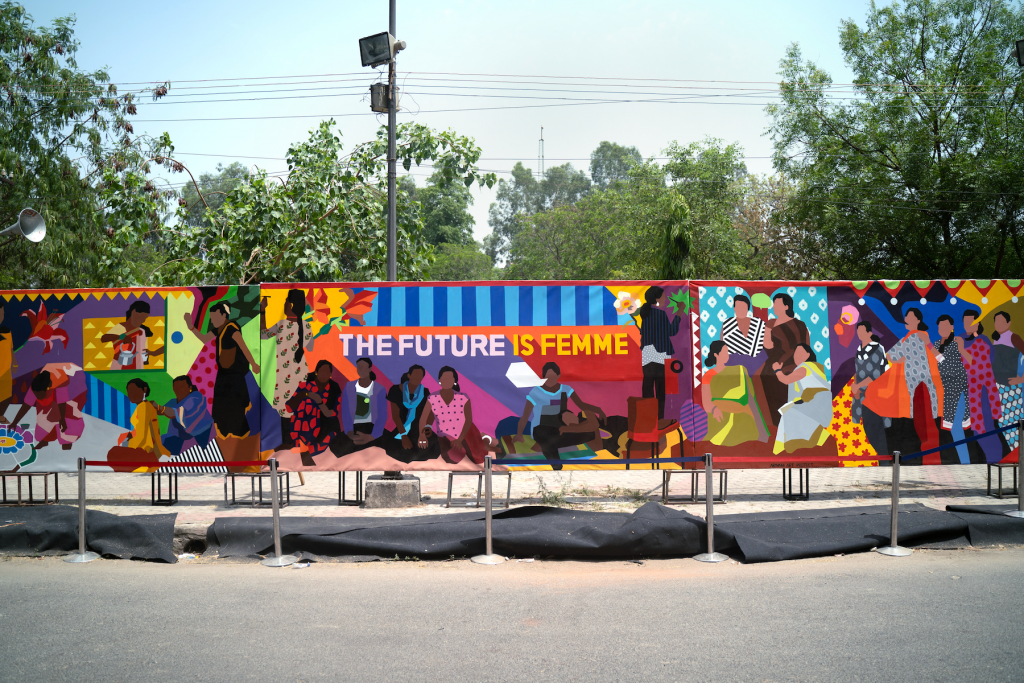
Trans art collective Aravani’s mural The Future is Femme. Photo: © India Art Fair.
In 2020, which was the last edition of the fair before the pandemic, police took down a political work installed at the Italian Embassy Culture Centre. Meanwhile, a women-led sit-in protest was staged in the neighborhood of Shaheen Bagh, just a short distance from the fair’s usual stomping grounds, which became the epicenter of a public movement that spread throughout the country. Blocking traffic on a major roadway, the peaceful protesters sought to overturn a set of xenophobic and casteist citizenship laws that has been issued by Narendra Modi’s BJP-led central government.
At this year’s fair, a massive mural painted by the trans art collective Aravani Art Project on the fair’s entrance proclaims: “The future is femme.” But otherwise, the organizers have notedly stayed away from taking overt political positions.
